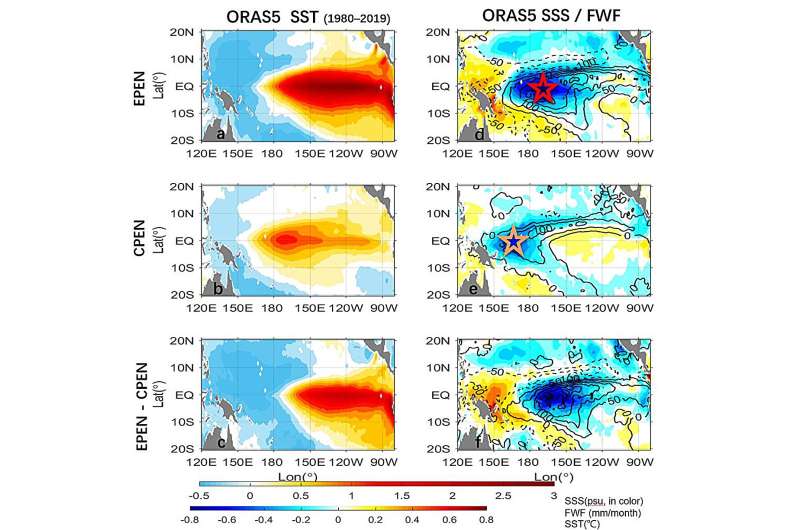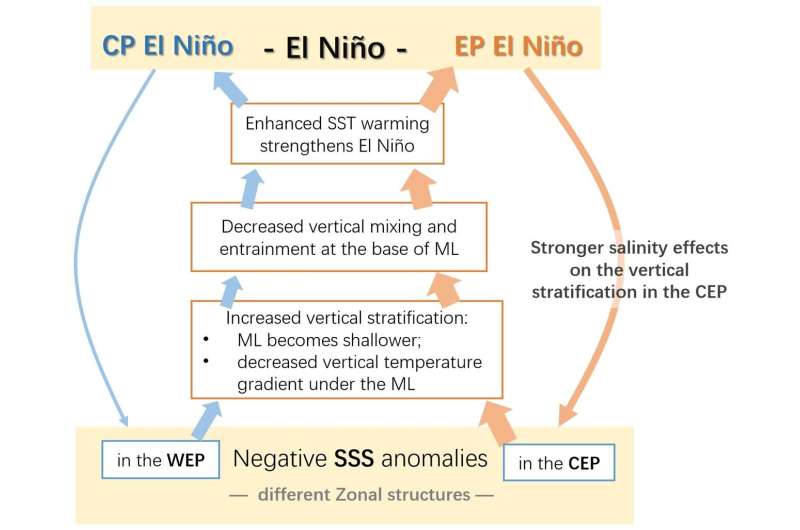This article has been reviewed according to Science X's editorial process and policies. Editors have highlighted the following attributes while ensuring the content's credibility:
fact-checked
trusted source
proofread
Study reveals how salinity affects El Niño diversity

The El Niño-Southern Oscillation (ENSO) is the strongest year-to-year climate variability in the planet, famous for prominent surface warming in the equatorial eastern Pacific known as an El Niño event.
Recent decades have recognized weaker surface warming located more westward in some years, named as the central Pacific El Niño (CPEN) in contrast to the traditional eastern Pacific El Niño (EPEN). Previous studies have underscored various air-sea processes in shaping these differences, however, the impact of salinity remains unknown.
Recently, a research team led by Prof. Wang Fan from the Institute of Oceanology of the Chinese Academy of Sciences (IOCAS) has revealed the dynamical mechanisms of ENSO diversity from the perspective of ocean salinity.
The study was published in Geophysical Research Letters on Oct. 31.
Based on Argo observations and reanalysis products, the researchers found maximum salinity anomalies during the two types of El Niño showed clear different zonal structure, which occurred in the central equatorial Pacific (CEP) during the EPEN and in further western equatorial Pacific (WEP) during CPEN.
"Ocean salinity plays active roles in developing El Niño warming through determining ocean vertical stratification and modifying the cooling entrainment and mixing from the subsurface, but we are curious about whether these different salinity zonal structures will affect the El Niño diversity," said Dr. Guan Cong, first author of the study.

Based on ocean model experiments, the researchers found that salinity effect on El Niño warming is very sensitive to zonal locations of salinity anomalies. The salinity anomalies located in the central Pacific are more effective in modulating local ocean vertical stratification, weakening the colder subsurface water into the mixed layer and further enhancing the surface warming.
Therefore, the central Pacific-located salinity anomalies during EPEN contributes to its stronger warming than those west-located salinity anomalies during CPEN, enhancing their sea surface temperature difference by 11%.
"Our results provide new insights in understanding the ENSO diversity and its low-frequency variability, which may be helpful for interpreting more complex model simulations and predicting ENSO variations," said Prof. Wang.
More information: Cong Guan et al, Zonal Structure of Tropical Pacific Surface Salinity Anomalies Affects the Eastern and Central Pacific El Niños Differently, Geophysical Research Letters (2023). DOI: 10.1029/2023GL105554
Provided by Chinese Academy of Sciences





















